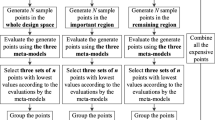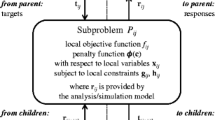Abstract
Design optimization of high-dimensional, computationally-expensive, and black-box problems has many challenges to resolve. Owing to the enormously high computational costs, obtaining the optimum design that has the minimum or maximum objective function value while satisfying constraints requires elaborated approaches. Instead, this paper suggests that if a design that satisfies a design target demanded by designers or decision makers can be obtained with low computational costs, the design could be quite useful for practitioners. To minimize the computational costs while obtaining the design, we aim to select the minimum number of significant input variables of a high-dimensional problem. Accordingly, a new design optimization problem for input variable selection, which is named design-target-based optimization (DTBO), is proposed to achieve it. The input variable selection is performed based on the selection measure that is calculated by the significance of input variables and the weights of each response. In the viewpoint of obtaining the design by minimally selecting the significant input variables, it is crucial to allocate weights appropriately by considering the status of constraints whether they are violated, active or inactive. Therefore, a penalty-Lagrange multiplier (PLM) method is also proposed for the DTBO to allocate weights adaptively. The performance and effectiveness of the DTBO for solving high-dimensional design problems are demonstrated by examining two numerical examples and the design of the body-in-white of a vehicle. We anticipate that the DTBO with the PLM method can obtain a practical design satisfying the design target efficiently.






Similar content being viewed by others
References
Arora JS (2017) Introduction to optimum design, 4th edn. Elsevier Korea LLC, Seoul
Bellman RE (1957) Dynamic programming, 1st edn. Princeton University Press, Princeton
Chen L, Qiu H, Gao L, Jiang C, Yang Z (2019) A screening-based gradient-enhanced Kriging modeling method for high-dimensional problems. Appl Math Model 69:15–31. https://doi.org/10.1016/j.apm.2018.11.048
Cho H, Bae S, Choi KK, Lamb D, Yang RJ (2014) An efficient variable screening method for effective surrogate models for reliability-based design optimization. Struct Multidisc Optim 50(5):717–738. https://doi.org/10.1007/s00158-014-1096-9
Constantine PG, Dow E, Wang QQ (2014) Active subspace methods in theory and practice: applications to kriging surfaces. SIAM J Sci Comput 36(6):A1500–A1524. https://doi.org/10.1137/130916138
Craig KJ, Stander N, Dooge DA, Varadappa S (2005) Automotive crashworthiness design using response surface-based variable screening and optimization. Eng Comput 22(1):38–61. https://doi.org/10.1108/02644400510572406
DiCiccio TJ, Efron B (1996) Bootstrap confidence intervals. Stat Sci 11(3):189–212. https://doi.org/10.1214/ss/1032280214
Davison AC, Hinkley DV, Schechtman E (1986) Efficient bootstrap simulation. Biometrika 73(3):555–566. https://doi.org/10.1093/biomet/73.3.555
Efron B, Tibshirani RJ (1994) An introduction to the bootstrap, 1st edn. Chapman & Hall/CRC, New York
Giovanis DG, Shields MD (2020) Data-driven surrogates for high dimensional models using Gaussian process regression on the Grassmann manifold. Comput Meth Appl Mech Eng 370:113269. https://doi.org/10.1016/j.cma.2020.113269
Golinski J (1970) Optimal synthesis problems solved by means of nonlinear programming and random methods. J Mech 5(3):287–309. https://doi.org/10.1016/0022-2569(70)90064-9
Gorostiaga A, Rojo-Alvarez JL (2016) On the use of conventional and statistical-learning techniques for the analysis of PISA results in Spain. Neurocomputing 171:625–637. https://doi.org/10.1016/j.neucom.2015.07.001
Johnson ME, Moore LM, Ylvisaker D (1990) Minimax and maximin distance designs. J Stat Plan Inference 26(2):131–148. https://doi.org/10.1016/0378-3758(90)90122-B
Kang K, Lee I (2021) Efficient high-dimensional metamodeling strategy using recursive decomposition coupled with sequential sampling method. Struct Multidisc Optim 63(1):375–390. https://doi.org/10.1007/s00158-020-02705-1
Khire RA, Messac A (2008) Selection-integrated optimization (SIO) methodology for optimal design of adaptive systems. J Mech Des 130(10):101401. https://doi.org/10.1115/1.2965365
Kim H, Lee TH (2021) A robust elastic net via bootstrap method under sampling uncertainty for significance analysis of high-dimensional design problems. Knowl Based Syst. https://doi.org/10.1016/j.knosys.2021.107117,107117
Kim H, Lee TH, Kwon T (2021) Normalized neighborhood component feature selection and feasible-improved weight allocation for input variable selection. Knowl Based Syst. https://doi.org/10.1016/j.knosys.2021.106855,106855
Kishore RA, Sanghadasa M, Priya S (2017) Optimization of segmented thermoelectric generator using Taguchi and ANOVA techniques. Sci Rep 7(1):16746. https://doi.org/10.1038/s41598-017-16372-8
Koch PN, Simpson TW, Allen JK, Mistree F (1999) Statistical approximations for multidisciplinary design optimization: the problem of size. J Aircr 36(1):275–286. https://doi.org/10.2514/2.2435
Lee K, Cho H, Lee I (2019) Variable selection using Gaussian process regression-based metrics for high-dimensional model approximation with limited data. Struct Multidisc Optim 59(5):1439–1454. https://doi.org/10.1007/s00158-018-2137-6
Li Y, Shi J, Yin Z, Shen J, Wu Y, Wang S (2021) An improved high-dimensional kriging surrogate modeling method through principal component dimension reduction. Mathematics 9(16):1985. https://doi.org/10.3390/math9161985
Liu Y, Li L, Zhao S (2022) A global surrogate model for high-dimensional structural systems based on partial least squares and Kriging. Mech Syst Signal Proc 164:108246. https://doi.org/10.1016/j.ymssp.2021.108246
Livermore Software Technology Corporation (2011) Full vehicle MDO. https://www.lsoptsupport.com/examples/optimization/full-vehicle-mdo/. Accessed 11 Nov 2021
Lophaven SN, Nielsen HB, Søndergaard J (2002) DACE: a matlab kriging toolbox. Informatics and Mathematical modeling, The Technical University of Denmark, report no.: IMM-TR-2002-12
Mckay MD, Beckman RJ, Conover WJ (1979) A comparison of three methods for selecting values of input variables in the analysis of output from a computer code. Technometrics 21(2):239–245. https://doi.org/10.1080/00401706.1979.10489755
Nievergelt J (2000) Exhaustive search, combinatorial optimization and enumeration: exploring the potential of raw computing power. Lect Notes Comput Sci 1963:18–35. https://doi.org/10.1007/3-540-44411-4_2
Ravindran A, Ragsdell KM, Reklaitis GV (2006) Engineering optimization: methods and applications. Wiley, New York
Sacks J, Welch WJ, Mitchell TJ, Wynn HP (1989) Design and analysis of computer experiments. Stat Sci 4(4):409–423. https://doi.org/10.1214/ss/1177012413
Shan SQ, Wang GG (2010) Survey of modeling and optimization strategies to solve high-dimensional design problems with computationally-expensive black-box functions. Struct Multidisc Optim 41(2):219–241. https://doi.org/10.1007/s00158-009-0420-2
Sloane NJA (2007) A library of orthogonal arrays. http://neilsloane.com/oadir/. Accessed 11 Nov 2021
Spagnol A, Riche RL, Veiga SD (2019) Global sensitivity analysis for optimization with variable selection. SIAM/ASA J Uncertain Quantif 7(2):417–443. https://doi.org/10.1137/18M1167978
Winkel MA, Stallrich JW, Storlie CB, Reich BJ (2021) Sequential optimization in locally important dimensions. Technometrics 63(2):236–248. https://doi.org/10.1080/00401706.2020.1714738
Wu YT, Mohanty S (2006) Variable screening and ranking using sampling-based sensitivity measures. Reliab Eng Syst Saf 91(6):634–647. https://doi.org/10.1016/j.ress.2005.05.004
Wu X, Peng X, Chen W, Zhang W (2019) A developed surrogate-based optimization framework combining HDMR-based modeling technique and TLBO algorithm for high-dimensional engineering problems. Struct Multidisc Optim 60(2):663–680. https://doi.org/10.1007/s00158-019-02228-4
Youn BD, Choi KK (2004) A new response surface methodology for reliability-based design optimization. Comput Struct 82(2–3):241–256. https://doi.org/10.1016/j.compstruc.2003.09.002
Yue X, Zhang J, Gong W, Luo M, Duan L (2021) An adaptive PCE-HDMR metamodeling approach for high-dimensional problems. Struct Multidisc Optim 64(1):141–162. https://doi.org/10.1007/s00158-021-02866-7
Zhang RD, Lv Q, Tao JL, Gao FR (2018) Data driven modeling using an optimal principle component analysis based neural network and its application to a nonlinear coke furnace. Ind Eng Chem Res 57(18):6344–6352. https://doi.org/10.1021/acs.iecr.8b00071
Zhou Y, Lu Z, Hu J, Hu Y (2020) Surrogate modeling of high-dimensional problems via data-driven polynomial chaos expansions and sparse partial least square. Comput Meth Appl Mech Eng 364:112906. https://doi.org/10.1016/j.cma.2020.112906
Zou H, Hastie T (2005) Regularization and variable selection via the elastic net. J R Stat Soc Ser B 67:301–320. https://doi.org/10.1111/j.1467-9868.2005.00503.x
Acknowledgements
The authors would like to acknowledge the financial support from the BK21 Four Education and Research Program for Automotive-Software Convergence funded by the Korean Government.
Funding
This work was supported by the BK21 Four Education and Research Program for Automotive-Software Convergence funded by the Korean Government (Grant No. 5199990814043).
Author information
Authors and Affiliations
Contributions
All authors contributed to the study conception and design and performed material preparation, data collection, and analysis. The first draft of the manuscript was written by HK and THL provided supervision, revised, edited, and commented on all the versions of the manuscript. All authors read and approved the final manuscript.
Corresponding author
Ethics declarations
Conflict of interest
The authors have no competing interests to declare that are relevant to the content of this article.
Replication of results
For readers interested in the specific process of the DTBO using input variable selection, Sects. 2 and 3 explain the basic principles. Kim and Lee’s paper also provides detailed explanations of the RENBOOT for significance analysis (Kim and Lee 2021), which was implemented using R statistical software. Algorithm 1 shows the main workflow of the code implementation for the DTBO using input variable selection. In particular, the selection measure and weight allocation can be calculated using Eqs. (11) to (15). The authors used lhsdesign with the maximin criterion (OLHD) in MATLAB 2021b for the initial dataset. For the kriging surrogate model, the DACE MATLAB toolbox (Lophaven et al. 2002) was used, and the MDD (Johnson et al. 1990) was used for the additional data points. Sequential quadratic programming in MATLAB 2021b was then used for optimization in the DTBO. The FE model of the BIW of a vehicle can be downloaded from LSTC (Livermore Software Technology Corporation 2011).
Additional information
Responsible Editor: Palaniappan Ramu
Publisher's Note
Springer Nature remains neutral with regard to jurisdictional claims in published maps and institutional affiliations.
Topical Collection: 14th World Congress of Structural and Multidisciplinary Optimization
Guest Editors: Y Noh, E Acar, J Carstensen, J Guest, J Norato, P Ramu
Rights and permissions
Springer Nature or its licensor holds exclusive rights to this article under a publishing agreement with the author(s) or other rightsholder(s); author self-archiving of the accepted manuscript version of this article is solely governed by the terms of such publishing agreement and applicable law.
About this article
Cite this article
Kim, H., Lee, T.H. Design-target-based optimization using input variable selection and penalty-Lagrange multiplier for high-dimensional design problems. Struct Multidisc Optim 65, 258 (2022). https://doi.org/10.1007/s00158-022-03356-0
Received:
Revised:
Accepted:
Published:
DOI: https://doi.org/10.1007/s00158-022-03356-0




